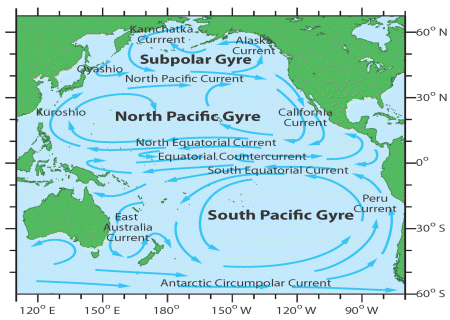2. The Ocean Gyres
Subtropical and subpolar gyres
The surface currents link up to form gyres - large areas defined by the currents flowing in a circular pattern. The largest are the subtropical gyres - in the Pacific, the North Pacific Current, the California Current and the North Equatorial Current form part of the North Pacific subtropical gyre. A fourth Current - the fast-flowing Kuroshio Current off the coast of Japan completes the circle.
The Pacific and Atlantic oceans each have two such subtropical gyres, one north and one south of the equator. The Indian Ocean does not reach as far north, and has only one gyre south of the equator.
There are also two sub-polar gyres - one in the North Pacific and one in the North Atlantic. These are much smaller, and shaped by the ocean basins. In the southern hemisphere, there is almost no land south of 40°S, the westerly wind known as the "Roaring Forties" drive the Antarctic Circumpolar Current (ACC), which circles the Antarctic continent in an eastward direction.
How wide, how fast, how deep?
The surface currents in a gyre vary in strength, width, and depth.
The warm western boundary current are fast, deep and narrow:
- The Gulf Stream in the South Atlantic and Kuroshio in the North Pacific are 50-75 km across and can flow at speeds of up to 3-4 km per hour (1 m s-1), but can be as fast as 7 km per hour ( 2 m s-1).
- The Agulhas Current along the African coast in the Southern Indian Ocean is about 100km across and can reach speeds of 2 m s-1.
The eastern boundary currents are cool and slow, moving at only 5-15 cm s-1.
Islands of water?
The currents forming the gyres enclose large areas of water where the current speed is very low. The centres of the gyres are all but cut off from the surrounding areas, rather like the traffic islands at the centre of a roundabout
Drifters released at the centre of a gyre would take a very long time to leave the gyre, and drifters that reach the centre of a gyre are often trapped there for years.
All calm in the subtropical gyres
The central regions of the subtropical ocean gyres are broad expanses of generally calm air associated with the subtropical high-pressure systems. The light winds means calm seas, with little mixing by waves. The strong sun heats the water to considerable depth, and also evaporates water from the surface, increasing the salinity (saltiness) of the water.
Below the warm ocean surface lies the thermocline - a layer where temperature decreases rapidly with depth. And under this is are the dark, cold waters of the deep ocean - an area where photosynthesis and plant life is impossible.
Because of the sharp difference in density between the surface and deep ocean (cold water is denser than warm water) the thermocline acts as a barrier to mixing between the surface and the deep. This has consequences for plant life in the ocean gyres - more about this in chapter 4: Currents and Life in the Ocean.


